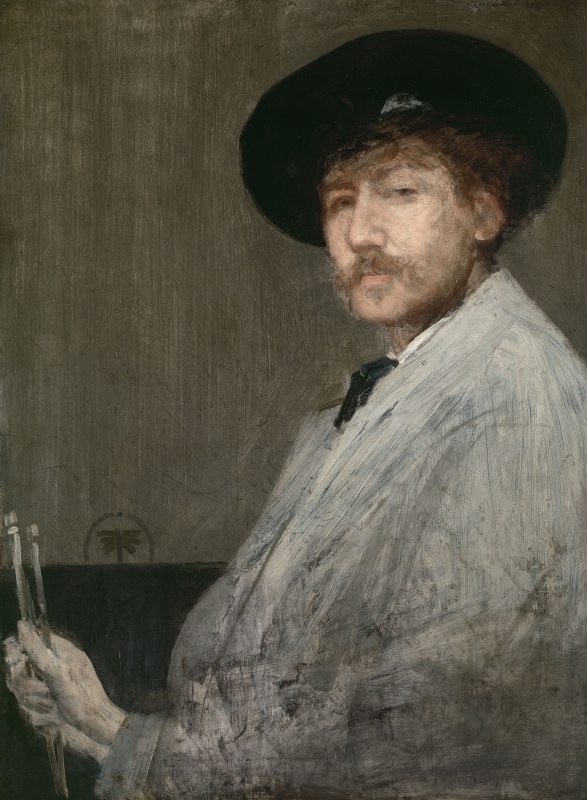Home > Catalogue > People > George Aloysius Lucas (related works) > Catalogue entry
Composition
The composition of Arrangement in Grey: Portrait of the Painter appears to reference that of Rembrandt’s Self-Portrait (1659, National Gallery of Art, Washington, DC), a very distinguished prototype. 1
Arrangement in Grey: Portrait of the Painter may be considered a pair with the portrait of his brother, Portrait of Dr William McNeill Whistler [YMSM 123]. It is the only oil self-portrait showing Whistler holding brushes (as well as sporting the conspicuous white lock).
An earlier study, The Artist in his Studio (Whistler in his Studio) [YMSM 063], dating from 1865/1872, shows the artist with brushes and palette (but no white lock of hair). Whistler was right-handed, and the study is a mirror image, showing him painting with his left hand. The pose is awkward, as it is in the Arrangement in Grey: Portrait of the Painter. It is just possible that the two paintings are related, for Whistler had intended to enlarge Whistler in his Studio, and the self-portrait could have been a stage in that project, which was ultimately abandoned.
Technique
The 'grey' of the title forms the background of this portrait, yellowish-grey paint being applied carefully with vertical strokes except where the brush follows the outline of the head. The face is painted more fluidly, modelled with small brushes (5mm), the strokes following the lines and planes of the face. Way and Dennis commented in 1903 on 'the swinging energy of the line of the head.' 2
Touches of blue and red, green and brown, not completely mixed into the flesh tones, are seen in the shadows of the face. Some of the layers of colour and the highlights may have been mixed with varnish, to give a translucent glow to the face.
The painting of the jacket is in total contrast to the technique used on the face: it is roughly shaped and crudely scraped down. The arms remain unresolved. The hand was originally painted thickly, and originally it was placed lower than at present, but then scraped down and painted more thinly in cool pink shaded with grey and brown, with a soft, slightly scumbled effect.
Frame
Flat Whistler frame, with basket-weave pattern painted on three flat panels, one, at left, being signed with a butterfly. The decoration is painted, not, as was more usual, incised. The butterfly interrupts the pattern and is not placed on top of the basket weave motif. 3 The portrait was probably framed for exhibition at Durand-Ruel's in Paris in 1873, at which time Whistler explained to George Aloysius Lucas (1824-1909), 'my frames I have designed as carefully as my pictures - and thus they form as important a part as any of the rest of the work - carrying on the particular harmony throughout.' 4
Notes:
1: See MacDonald 2003 [more] , p. 8. See also Stephenson, Andrew, ‘Refashioning Modern Masculinity: Whistler, Aestheticism and National Identity’, in Corbett: David Peters, and Lara Perry (eds.), English Art 1860-1914. Modern Artists and Identity, Manchester, 2000, pp. 133-49, at pp. 141-42.
2: Way & Dennis 1903 [more] , p. 39.
3: Dr Sarah L. Parkerson Day, Report on frames, 2017; see also Parkerson 2007 [more] .
Last updated: 31st December 2020 by Margaret









